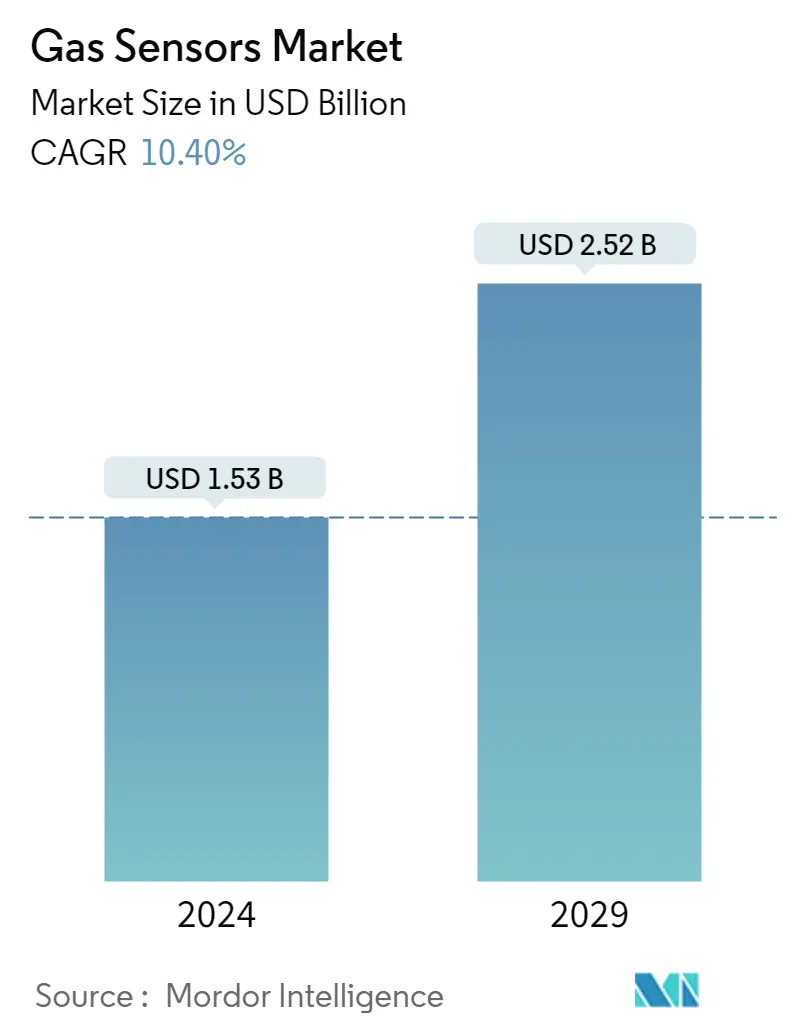Market Size of Gas Sensors Industry

| Study Period | 2019 - 2029 |
| Market Size (2024) | USD 1.53 Billion |
| Market Size (2029) | USD 2.52 Billion |
| CAGR (2024 - 2029) | 10.40 % |
| Fastest Growing Market | Asia Pacific |
| Largest Market | North America |
Major Players
*Disclaimer: Major Players sorted in no particular order |
Need a report that reflects how COVID-19 has impacted this market and its growth?
Gas Sensors Market Analysis
The Gas Sensors Market size is estimated at USD 1.53 billion in 2024, and is expected to reach USD 2.52 billion by 2029, growing at a CAGR of 10.40% during the forecast period (2024-2029).
- The evolution of wireless capabilities and miniaturization, along with improved communication capabilities that facilitate their integration into different devices and machines without minimizing the detection capabilities of toxic or flammable gases at safe distances, propels the gas sensors market. In addition to this, the COVID-19 pandemic further stressed the crucial role of maintaining air quality, especially indoor air quality, whether at the office, home, or other public spaces.
- Notably, the industrial production process not only involves the use of various gases but also shares a considerable share of the overall environmental emissions. The government regulates the leakage of such gases, and this is where the demand for gas sensors is increasing. For instance, the EU incorporated Directive 2010/75/EU, an instrumental regulation in controlling pollutant emissions into the atmosphere by industrial installations. Moreover, recently, the EU policymakers proposed legislation for making oil and gas companies report their domestic methane emissions and fix leaks of the potent greenhouse gas. This is because Methane is the second biggest reason for climate change after carbon dioxide and has led to a significantly large warming effect, meaning deep cuts in global methane emissions are required this decade to avert disastrous climate change.
- Governments all over the world and political bodies are largely setting targets to decrease the emission of greenhouse gases. For example, the EU has set itself a goal of net-zero greenhouse gas emissions by 2050. Also, countries such as China, the United States, India, and Russia are increasingly adopting stringent regulations to tackle emission rates.
- Recently, in August 2022, the Union Cabinet of India approved India’s updated Nationally Determined Contribution (NDC) for commitment towards the reduction of emissions intensity of its GDP by about 45 percent by 2030, compared to the 2005 level and attain about 50 percent integrated electric power installed capacity from non-fossil fuel-based energy resources by 2030.
- Moreover, government regulations for workplace and labor safety are increasingly becoming stringent, and adherence to such rules is vital in business continuity for organizations. For instance, in Europe, EU-OSHA does this by bringing together European workplaces to share information and knowledge for promoting a culture of risk prevention, and the OSH framework, announced in the European Pillar of Social Rights action plan 5, sets out the crucial priorities and actions necessary for enhancing workers’ health and safety in the upcoming years in the context of the post-pandemic world.
- Such regulations have increased the demand for gas sensors by requiring employers to take measures to protect workers from hazards in the workplace, such as exposure to hazardous gases.
- Gas sensors present in conventional power plants have been surging to limit emissions of pollutants, such as sulfur oxides, mercury, nitrogen, and carbon dioxide, owing to the stringent government regulations for attaining sustainability goals. These try to minimize greenhouse emissions and other types of pollution by using resources effectively. Sensors contribute to surged turbine efficiency, more plant safety, low transmission losses, and low environmental impact.
- Furthermore, the developing nature of the market is resulting in rapid changes and the availability of different types of sensors for major gases like carbon monoxide and carbon dioxide. Additionally, increasing costs are also an issue in the ever-changing market, along with innovations and low product differentiation.
